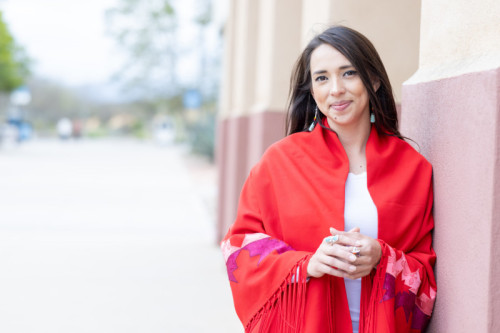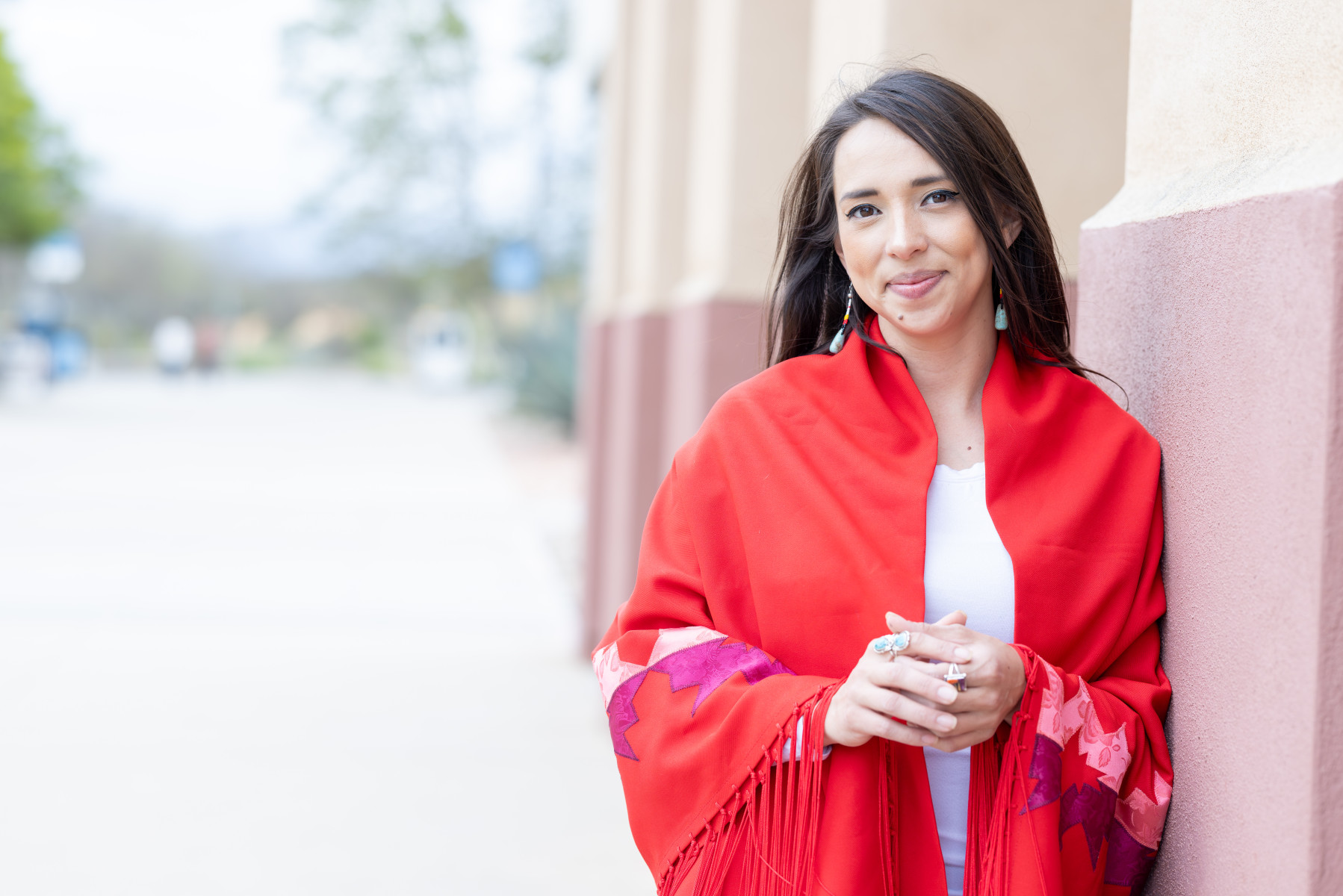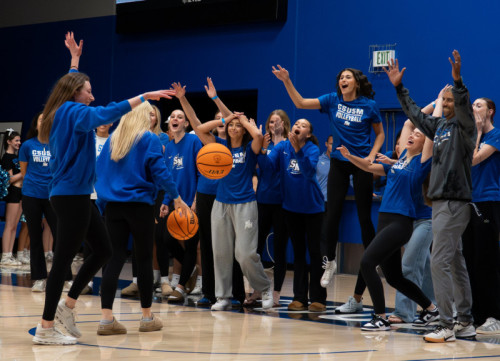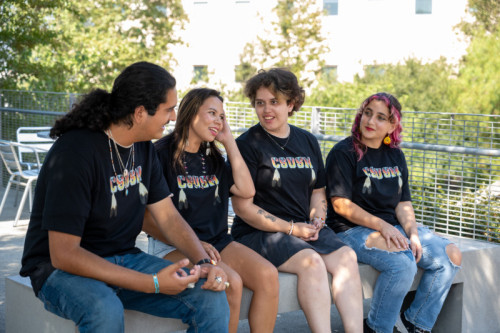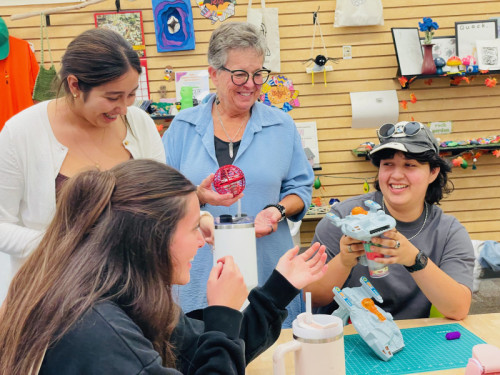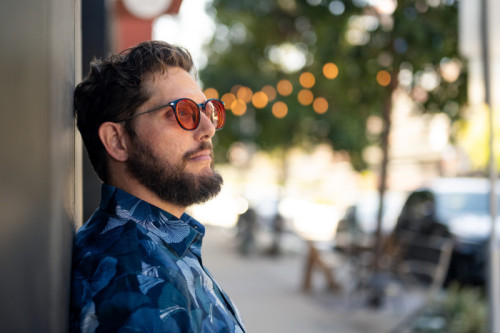Alumna Finds Purpose in Advocacy for Native Children and Families
29
October
2025
|
08:00 AM
America/Los_Angeles
By Bri Phillips
"; items += "
"; items += "
"; items += "
" + val['title'] + "
"; if(val['subtitle']){ items += "
" + val['subtitle'] + "
"; } items += "
"; if ((val['showpublishdate'] !== 0 && showPublishDateHeadlineSetting) || showPublishCityHeadlineSetting) { items += '
'; if (val['publishcity'] && showPublishCityHeadlineSetting) { items += '
' + val['publishcity'] + '
'; } if (val['showpublishdate'] !== 0 && showPublishDateHeadlineSetting) { items += "
"; items += "
" + date_month + "
"; items += "
" + date_day + "
,"; items += "
" + date_year + "
"; items += '
'; items += ' | '; items += '' + val['publish_time'] + ''; items += 'America/Los_Angeles'; items += '
'; items += '
'; } items += '
'; } items += "
" + val['message'] + "
"; items += "
Read more
"; items += "
"; items += ""; items += tags_items; items += multimedia_count; items += "
Latest News Release
- Photo Highlights From Cougar MadnessCal State San Marcos students filled The Sports Center on Oct. 15 for Cougar Madness, the university's annual event celebrating the beginning of the college basketball season. The men's basketball team opens the regular season by hosting Concordia University on Nov. 14. The women's team also opens Nov. 14 with a home game against Azusa Pacific. Visit the athletics website for complete schedules for both teams. Relive some of the event highlights in the Cougar Madness photo slideshow. Media Contact Eric Breier, Interim Assistant Director of Editorial and External Affairs ebreier@csusm.edu | Office: 760-750-7314
- Seeking Healthy Adults to Participate in Exercise Training StudyHealthy adults ages 18 - 64 years old who exercise less than two days per week are needed to participate in an exercise training study conducted at CSUSM. Participants will complete 2 sessions per week of exercise for 12 weeks, during which time you must maintain your lifestyle. Upon completion of the study, you will be paid $250.00. Please email Dr. Todd A. Astorino, Dept. of Kinesiology, at astorino@csusm.edu for more information about the study.
- Celebrating Native American Heritage MonthThroughout November, Cal State San Marcos will be celebrating and recognizing the contributions of American Indians with a series of special events as part of Native American Heritage Month. CSUSM invites all members of the campus community to participate in the following events. Pow Wow Dance Workshops Tuesday, Nov. 4, 11, 18, 6-8 p.m., Serenity Circle Learn the history, meaning and movement of pow wow dancing in this interactive workshop led by Kiara Flores. Celebrate culture, community and tradition through dance. Chow on Deck: United in Service - A Celebration of Native American Veterans Tuesday, Nov. 4, noon, Epstein Family Veterans Center Deck American Indian Student Center NAHM Kick-Off Event Friday, Nov. 7, 5-8 p.m., USU Amphitheater CSUSM’s American Indian Student Center invites the campus community to celebrate the start of Native American Heritage Month. The evening will include traditional bird singing, pow wow dancing and storytelling along with food prepared by Chef Carmen of Island Smoke N’ Grill. CSUSM 2nd Annual Social Gathering Thursday, Nov. 20, 3-6:30 p.m., Mangrum Track & Field The event will feature traditional bird singers and dancers, along with local vendors showcasing Native art and jewelry. All are welcome to join in this celebration of community and culture. Media Contact Eric Breier, Interim Assistant Director of Editorial and External Affairs ebreier@csusm.edu | Office: 760-750-7314
- Human Development Students Rediscover the Power of PlayWhen Cal State San Marcos human development instructor Kathy Fuller gathered her students for class recently, she didn’t hand out a lecture outline or cue up a PowerPoint. Instead, she invited them to The Makery, a hands-on, creative space in Kellogg Library, and gave them a simple instruction: play. She encouraged them to tinker, build, explore and let curiosity lead the way. It might have looked like fun and games from the outside, but for Fuller, the experience was a deliberate lesson in rediscovering something that many adults forget. “In our adult lives, we lose touch with play,” Fuller said. “But rediscovering it isn’t just about having fun – it’s a way to connect, build trust and spark creativity.” For Fuller’s human development students – most of whom are preparing for careers as counselors, educators or community advocates – the exercise carried a deeper meaning. Play, she explained, is a bridge to empathy and understanding, essential tools for working with people who are coping with stress, trauma or isolation. “Play builds trust, opens pathways for expression and helps people feel safe,” Fuller said. “It reminds us that learning and healing don’t always have to be serious. Sometimes they can be spontaneous.” Among those who found the experience unexpectedly refreshing was Daniel Lopez, a human development major and student ambassador for the College of Education, Health and Human Services. “Sometimes we get so focused on grades and deadlines that we forget how to just explore and enjoy the process,” Lopez said. “This experience reminded me that play isn’t just for kids – it’s a mindset that helps us stay creative, connect with others and bring joy into the work we’ll be doing in our future careers.” Fuller’s playful experiment also reflects the broader mission of CEHHS, which emphasizes holistic, human-centered approaches to learning and practice. In the end, the lesson was simple but profound: There’s room and real need for play in the serious work of helping others. Media Contact Brian Hiro, Communications Specialist bhiro@csusm.edu | Office: 760-750-7306
- After Surviving Battle With Hep C, Alumnus Now Helps Others Do SameRichard Jaenisch had received a death sentence at age 12. Diagnosed with hepatitis C, very unusual for a child that young, Jaenisch had been told by doctors that if he didn’t get a liver transplant, he wouldn’t live past 30. That disturbing prediction had hung over his adolescence and early adulthood like a black cloud, casting a pall over every doctor’s appointment and health episode. Now here it was, 2016, the year when Jaenisch turned 30, and the doctor’s assessment was feeling eerily prescient. He had not been able to procure a new liver, and his condition was deteriorating rapidly. To borrow his gallows humor, he was as “yellow as a Simpsons character” because of jaundice. He collectively spent more than six weeks in the hospital as a result of various complications from end-stage liver disease. “Every single day that year, I had a 30 to 60 percent chance of dying,” Jaenisch said. That he didn’t die, that he received a liver transplant on Dec. 3 (only a few months before his 31st birthday), Jaenisch considers to be nothing short of a miracle. Given the gift of fresh life in his fourth decade, he elected to devote it to ensuring that no one else has to go through the ordeal that he did. Three years later, Jaenisch returned to Cal State San Marcos – the university where he had earned a bachelor’s degree in social sciences in 2008 – to pursue a master’s in public health. He now works as the director of education and outreach for Open Biopharma Research and Training Institute, a Carlsbad nonprofit whose mission is to reduce the cost of pharmaceuticals like the ones that helped keep him alive while he waited for the miracle liver. More significantly, Jaenisch is a tireless patient advocate, dedicating countless hours to multiple organizations that share a goal of ending the scourge of hep C. He has transformed adversity into community impact, leveraging his CSUSM education to improve lives and strengthen public health across the state. “Richard is truly a special person,” said Carrie Frenette, the executive director of global medical affairs for Gilead Sciences and Jaenisch’s liver doctor for nine years starting in 2012. “I can’t think of anyone else who has so much expertise and understanding in their medical problems, advocates for themselves and then goes on to advocate for others. Honestly, it made it so easy to care for him, and it made it mean even more when he got his transplant and was healthy again.” 'I don’t know how you are still alive...’ It all started with brown pee. Jaenisch was a normal suburban kid growing up in Rancho Bernardo. When he was 12, his parents signed him up for a summer tennis camp. It was a sweltering day and he didn’t drink a lot of water; when he returned home and went to the bathroom, his urine was dark. His father took him to Rady Children’s Hospital, where he was put through a battery of tests on his kidneys, spleen and liver. The diagnosis of hepatitis C virus (HCV) stunned them, as did the subsequent wallop of bad news: After the rest of the family was tested, it was discovered that he contracted the infection at birth from his mother, who also was found to have HCV. Nothing, though, could have prepared Jaenisch for the haunting prognostication of liver transplant or death. “That shook me to my core,” he said. “My childhood was fundamentally changed. And my mom heard that, too, because she was in the room. It’s awkward hearing your own future from your child’s diagnosis. We shared a very odd relationship in that way.” At the time, in the late 1990s, there was no cure for HCV, only experimental treatments with low success rates and punishing side effects. Jaenisch’s mom started the drugs – interferon and ribavirin – almost immediately, but as a child, Jaenisch wasn’t eligible. The primary impact of HCV on his teenage years was that he was forced to cease participation in all sports and PE classes (because the disease can be transmitted through blood) and he began to suffer from a type of brain fog named hepatic encephalopathy (HE). After graduating from Rancho Bernardo High School, he attended Palomar College for two years, then transferred to CSUSM. There, he threw himself into classes in economics, history and political science – not only to satiate his hunger for knowledge but also to distract himself from the fear that constantly lingered at the back of his mind. “I wanted to live as much of my life as I could before everything hit the fan,” Jaenisch said. “Because I knew what was coming. When someone gives you a death sentence, you remember it, to say the least.” Jaenisch graduated from CSUSM in December 2008. Only a few weeks later, the trouble started. He attempted to begin the same treatment program his mom had undergone, but because of denials by his mom's employer, he wasn’t able to do so for about nine months. Once the snags finally had been resolved, the 12-week regimen of interferon and ribavirin didn’t work. He experienced all the negative effects of the drugs – in his case, painful inflammation and wild emotional swings – without any decrease in his body’s viral load. A second round at double the dosage early in 2010 similarly yielded no response. By this point, more than a decade after his HCV first had been discovered, Jaenisch had descended to the most serious stage on the scale that measures liver fibrosis, or scarring. F0 equates to no fibrosis, F1 is mild, F2 is moderate, and so on. He was at F4, which indicates the presence of cirrhosis, a condition in which the liver is extensively scarred and permanently damaged. Jaenisch had reached the dreaded end-stage liver disease, which essentially meant that the ticking of his clock was only accelerating. All the while, he was encountering roadblocks in his career. He had hoped to enter the niche field of traffic economics, but graduating into the Great Recession scuttled that plan. For a time, he held a job in tech support that he found unfulfilling. The work that did bring Jaenisch joy was for a group that offered before- and after-school services for elementary and middle schools in the Poway district of his youth. He envisioned a long-term future in that field but was stymied by both the ailing economy (which led to layoffs) and his illness (he claims he was a victim of disability discrimination but chose to spend his remaining time trying to get better rather than pursue a case.) While he tried to piece together enough work to retain his vital health insurance, Jaenisch’s health continued to deteriorate. In 2014, two years into her stint as his liver doctor, Frenette proffered a grim evaluation. “She said, ‘I don’t know how you are still alive with this liver,’ ” Jaenisch recalled. “She showed me pictures and was like, ‘Your liver is an old shoe. It is not doing what it’s supposed to do. But you’re still functioning.’ ” Every moment of optimism, it seemed, was followed by a stroke of misfortune. He began taking a new drug called Sovaldi (a direct-acting antiviral, or DAA) that was considered a game-changer for HCV patients in that it had an 86% cure rate in six months. Sure enough, Jaenisch’s viral load was approaching zero and his liver was curing. But then he contracted a C. diff bacterial infection (the suspect: spoiled food from a restaurant), which caused acute liver failure and brought his HVC roaring back. He later tried another second-generation DAA – Harvoni – that sounded promising but failed in the last week of treatment. As his liver continued to deteriorate, in 2016 he became too sick for treatment and, following a now-common hospitalization, an ER physician gave him outdated medical advice, which resulted in a case of sepsis that nearly killed him. End-stage liver disease is typically a rapid descent lasting as little as two years. For Jaenisch, it was an eight-year slog, from age 22 to 30. “He was in and out of the hospital multiple times, and he nearly didn’t make it to transplant multiple times,” Frenette said. “I can’t imagine anyone going through it with the courage and strength that he did.” Even after the liver transplant, Jaenisch wasn’t out of the woods. The operation addressed the issue of the failing liver, but it didn’t eradicate the HCV (the virus lives in the bloodstream). Frenette advised a treatment plan of Sovaldi, Zepatier and ribavirin, and that pharmaceutical concoction proved to be a magical formula. In September 2017, 18 years after the fateful diagnosis, Jaenisch was cured. “Honestly, I cried,” Frenette said. “He had been through so much, and to finally get rid of this awful virus that he had lived with his entire life and had caused his liver to fail … I don’t have words.” ‘I have to be more than a self-advocate' It was during one of his dozens of hospital stays that Jaenisch decided on the next course of his life, provided he would live long enough to choose. In the fall of 2014, he had been admitted to Sharp Memorial Hospital after the HCV returned via his C. diff infection. His medical team was struggling to lower his levels of bilirubin, a substance found in bile that was causing jaundice, the yellowing of the skin now so familiar to Jaenisch. He knew that ultraviolet rays help break down bilirubin, so he convinced the nurses to bring him outside for an hour a day at peak sun. As he had theorized, his bilirubin numbers declined. “It was at that point where I was like, ‘I have to be more than a self-advocate. If I can survive through transplant, I need to go to a Master of Public Health program,’ ” Jaenisch said. “I realized that that path would help me better understand how to become an advocate not only for myself but also for others.” His commitment would be nurtured in an environment like CSUSM, as he was accepted into its accelerated MPH program. His time back at the university overlapped with the pandemic, which he took advantage of by choosing as his thesis topic the emergency use authorization of COVID-19 tests. “He was very inquisitive and passionate,” said Asherlev Santos, an associate professor of public health and Jaenisch’s thesis adviser. “Sometimes that passion was more visible than the evidence of the inquiry, but all came from a place of helping others in some sort of need. He used his personal and professional experience to spur on what he did for his MPH degree.” His master’s allowed him to land his job at Open Biopharma, but it’s passion that mostly fuels Jaenisch in his advocacy connected to HCV. In 2016, while his body was still racked with the disease, he traveled to Sacramento with an organization known as CalHEP to talk to state legislators and raise awareness about viral hepatitis. The next year, when Congress was preparing to vote on a bill to repeal the Affordable Care Act, Jaenisch enlisted in the fight. He told his story of overcoming HCV in half a dozen TV interviews, worked at a call center, wrote letters – he did so much that the American Liver Foundation named him its liver champion of the year. “I wanted to preserve the things that help people get access to health care,” he said. “Because to me, it saved my life.” He also has volunteered for state and local groups such as End the Epidemics, the California Department of Public Health and the Eliminate Hepatitis C San Diego County Initiative. Their shared objective (in line with a goal established by the World Health Organization) is to eliminate hep C by 2030, which means a reduction of new infections by 90% and deaths by 65%. And the barriers are much lower than they used to be. Jaenisch says his family spent hundreds of thousands of dollars on treatment and other expenses to keep him alive. Today, treatment could run as cheap as a few hundred dollars, and that’s for more effective drugs, too. “I was raised in a middle-class suburban household, and I wouldn’t have known I had hep C if I didn’t pee a brown color,” Jaenisch said. “I’ve always maintained that I think we’re missing a lot of people, and I keep trying to push for us to find them and knock this virus out. We’re taking a lot of steps, and eventually we’ll get there.” Thanks to Jaenisch’s focus on access and innovation, those steps are becoming strides – toward a healthier, more equitable future for all. Media Contact Brian Hiro, Communications Specialist bhiro@csusm.edu | Office: 760-750-7306
- Attend Campus Webinar for Information on AB 481 Regulated Equipment ReportAs part of the university's commitment to transparency and open communication, the University Police Department (UPD) will host a webinar on Thursday, Oct. 30 at noon via Zoom (https://csusm.zoom.us/j/83186146403) . The Zoom meeting ID is 831 8614 6403. This webinar will provide information from the annual AB 481 Regulated Equipment report. Every year, agencies must report any military equipment used as part of their operations. This webinar is open to all CSUSM students, faculty and staff. No registration is required. For more about UPD policies, contact information and other campus services, visit www.csusm.edu/police.



